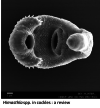Himasthla spp. (Trematoda) In The Edible Cockle Cerastoderma edule: Review, Long-Term Monitoring And New Molecular Insights
- PMID: 35352675
- PMCID: PMC10090617
- DOI: 10.1017/S0031182022000373
Himasthla spp. (Trematoda) In The Edible Cockle Cerastoderma edule: Review, Long-Term Monitoring And New Molecular Insights
Abstract
Trematodes are the main macroparasites in coastal waters. The most abundant and widespread form of these parasites is metacercaria. Their impact on their host fitness is considered relatively low but metacercarial larvae of some species can have deleterious effects on individuals and/or populations. This review focused on the cockle Cerastoderma edule and four species of the genus Himasthla; a common host–parasite system in marine coastal environments. Our aims were (1) to review literature concerning Himasthla continua, Himasthla elongata, Himasthla interrupta and Himasthla quissetensis in cockles; (2) to provide molecular signatures of these parasites and (3) to analyse infection patterns using a 20-year monthly database of cockle monitoring from Banc d'Arguin (France). Due to identification uncertainties, the analysis of the database was restricted to H. interrupta and H. quissetensis, and it was revealed that these parasites infect cockles of the same size range. The intensity of parasites increased with cockle size/age. During the colder months, the mean parasite intensity of a cockle cohort decreased, while infection occurred in the warmest season. No inter-specific competition between trematode parasites was detected. Furthermore, even if the intensity of H. interrupta or H. quissetensis infection fluctuated in different years, this did not modify the trematode community structure in the cockles. The intensity of infection of both species was also positively correlated with trematode species richness and metacercarial abundance. This study highlighted the possible detrimental role of Himasthla spp. in cockle population dynamics. It also revealed the risks of misidentification, which should be resolved by further molecular approaches.
Conflict of interest statement
The authors declare there are no conflicts of interest.
Figures





Similar articles
-
Trematode communities in cockles (Cerastoderma edule) of the Ria de Aveiro (Portugal): influence of inorganic contamination.Mar Pollut Bull. 2014 May 15;82(1-2):117-26. doi: 10.1016/j.marpolbul.2014.03.012. Epub 2014 Mar 27. Mar Pollut Bull. 2014. PMID: 24680719
-
Interaction between non-specific electrostatic forces and humoral factors in haemocyte attachment and encapsulation in the edible cockle, Cerastoderma edule.J Exp Biol. 2006 Apr;209(Pt 7):1326-35. doi: 10.1242/jeb.02118. J Exp Biol. 2006. PMID: 16547303
-
Evidence of an altered protective effect of metallothioneins after cadmium exposure in the digenean parasite-infected cockle (Cerastoderma edule).Parasitology. 2007 Feb;134(Pt 2):237-45. doi: 10.1017/S0031182006001375. Epub 2006 Oct 11. Parasitology. 2007. PMID: 17032474
-
Review: Bucephalus minimus, a deleterious trematode parasite of cockles Cerastoderma spp.Parasitol Res. 2015 Apr;114(4):1263-78. doi: 10.1007/s00436-015-4374-6. Epub 2015 Feb 15. Parasitol Res. 2015. PMID: 25681142 Review.
-
Monorchis parvus and Gymnophallus choledochus: two trematode species infecting cockles as first and second intermediate host.Parasitology. 2020 May;147(6):643-658. doi: 10.1017/S0031182020000402. Epub 2020 Mar 4. Parasitology. 2020. PMID: 32127062 Free PMC article. Review.
Cited by
-
Morphological vs. molecular identification of trematode species infecting the edible cockle Cerastoderma edule across Europe.Int J Parasitol Parasites Wildl. 2024 Nov 14;25:101019. doi: 10.1016/j.ijppaw.2024.101019. eCollection 2024 Dec. Int J Parasitol Parasites Wildl. 2024. PMID: 39687765 Free PMC article.
References
-
- André C, Jonsson P and Lindegarth M (1993) Predation on settling bivalve larvae by benthic suspension feeders: the role of hydrodynamics and larval behaviour. Marine Ecology Progress Series 97, 183–192.
-
- Bartoli P and Gibson DI (2007) Synopsis of the life cycles of Digenea (Platyhelminthes) from lagoons of the northern coast of the western Mediterranean. Journal of Natural History 41, 1553–1570.
-
- Baudrimont M and de Montaudouin X (2006) Evidence of an altered protective effect of metallothioneins after cadmium exposure in the digenean parasite-infected cockle (Cerastoderma edule). Parasitology 134, 237–245. - PubMed
-
- Baudrimont M, de Montaudouin X and Palvadeau A (2006) Impact of digenean parasite infection on metallothionein synthesis by the cockle (Cerastoderma edule): a multivariate field monitoring. Marine Pollution Bulletin 52, 494–502. - PubMed
-
- Bhattacharya CG (1967) A simple method of resolution of a distribution into Gaussian components. Biometrics 23, 115–135. - PubMed
Publication types
LinkOut - more resources
Full Text Sources
Miscellaneous

